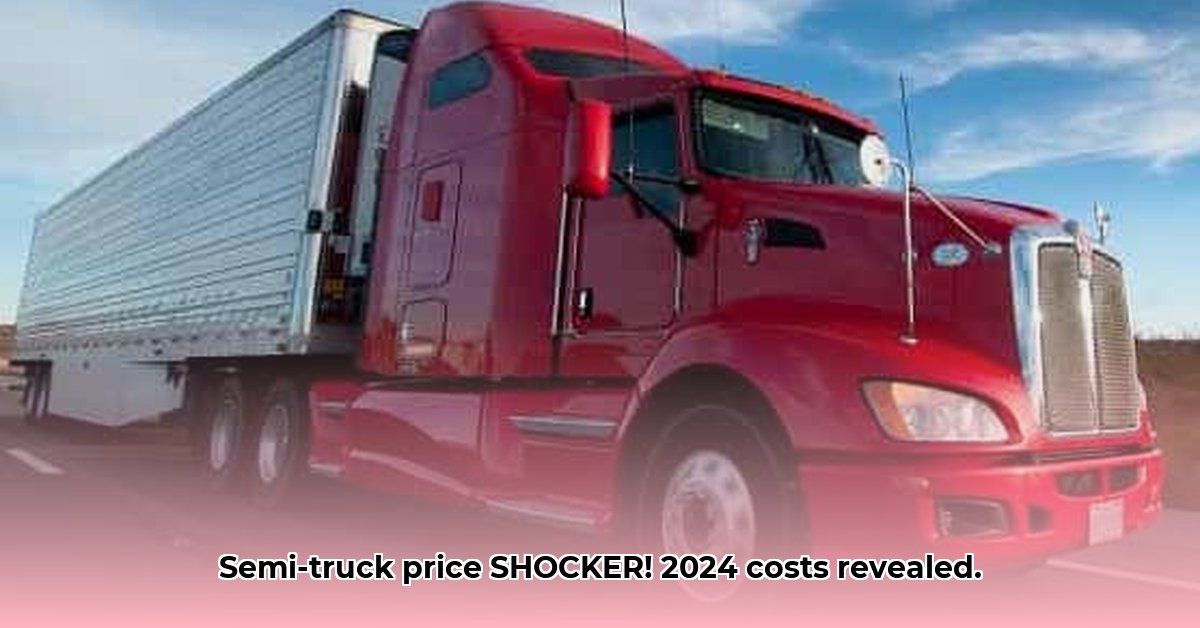
Buying a semi-tractor is a major investment. The cost varies significantly, depending on several factors. This guide provides a comprehensive overview to help you make an informed decision, whether you're an owner-operator, part of a large fleet, or a financial institution evaluating the market. For more on farm tractor costs, check out this helpful resource: Farm Tractor Costs.
Understanding the Price Range of Semi-Tractors
The price of a new semi-tractor in 2024 ranges dramatically. A basic day cab model (a truck without a sleeper berth for overnight stays) might start around $75,000. However, a high-end sleeper cab with advanced features can easily exceed $300,000. This wide range reflects the diverse needs and preferences of different haulers. What are your specific needs?
Factors Influencing Semi-Tractor Costs
Several key factors contribute to the significant price variations in semi-tractors:
Cab Type: Day cabs, suitable for local deliveries, are less expensive than sleeper cabs, designed for long-haul drivers and equipped with living quarters. The added space and amenities significantly increase the cost. Do you need a sleeper cab for long hauls or a day cab for shorter routes?
Engine Power: Higher horsepower engines generally command higher prices. However, these engines may offer superior fuel efficiency, potentially offsetting the higher initial cost over the truck's lifespan. Consider long-term fuel costs versus initial investment.
Cargo Capacity: Larger trucks capable of hauling heavier loads carry a proportionally higher price tag. Your choice will depend on the types and weights of goods you will transport.
Fuel Efficiency: Trucks with advanced fuel-efficient engines have a higher initial cost but offer substantial long-term savings on fuel, a critical factor for profitability, especially in long-haul trucking. What is your annual mileage estimate?
Manufacturer: Different manufacturers offer varying levels of quality, features, and technological advancements, all affecting the final price. Research and compare models from several reputable manufacturers.
Financing and Leasing Options: Spreading the Cost
The overall cost is also affected by your chosen financing method. Leasing offers lower monthly payments, but you return the truck at the lease's end. Financing requires a larger down payment but results in eventual ownership. Which option aligns best with your financial situation and long-term goals?
Ongoing Costs Beyond the Initial Purchase Price
The initial purchase price is only the beginning. You must also budget for:
Insurance: Insurance costs are influenced by the truck's value, your driving record, and the type of coverage. Obtain several quotes to secure the best rate.
Maintenance: Regular maintenance is essential to prevent costly breakdowns. Factor in the costs of routine servicing and potential repairs.
Fuel: Fuel costs are highly variable and depend on market conditions and fuel efficiency of the vehicle. Develop a budget that accounts for fluctuations in fuel prices.
A Step-by-Step Guide to Buying a Semi-Tractor
Purchasing a semi-tractor should be a calculated process. Follow these steps:
Define Your Operational Needs: Determine the type of hauling (long-haul or local), cargo type, and expected annual mileage.
Conduct Thorough Research: Explore various manufacturers and models, comparing specifications, features, and reviews to inform your choice.
Explore Financing Options: Research loan terms and interest rates from banks and leasing companies.
Develop a Comprehensive Budget: Create a detailed budget encompassing purchase price, insurance, maintenance, fuel, and other operating expenses.
Seek Professional Guidance: Consult with trucking industry professionals or financial advisors for personalized advice, particularly if you require financing.
Stakeholder Perspectives on Semi-Tractor Costs
Different stakeholders view semi-tractor costs differently:
| Stakeholder | Short-Term Focus | Long-Term Focus |
|---|---|---|
| Owner-Operators | Securing financing, finding the right truck | Fuel efficiency, maximizing profits, long-term maintenance |
| Large Fleets | Return on investment (ROI), fleet expansion | Fuel economy, minimizing downtime, technological upgrades |
| Manufacturers | Innovation in fuel efficiency and safety | Maintaining market share, building strong customer relationships |
| Financial Institutions | Providing competitive financing and leasing options | Managing risk, predicting industry trends |
"Understanding the varying perspectives is crucial for smart buying decisions," says Dr. Emily Carter, Professor of Transportation Economics at MIT. "Each stakeholder has different priorities impacting their approach to cost analysis."
Leasing a Fuel-Efficient Semi-Tractor for Long-Haul Operations
Leasing offers an appealing option for long-haul operations, especially if fuel efficiency is prioritized. However, careful planning is crucial to avoid hidden costs. Key considerations include fuel efficiency, careful selection of a leasing company, contract review, financial projections, and the impact of your credit score.
Key Takeaways on Leasing:
- Leasing reduces upfront costs but involves ongoing monthly payments.
- Fuel efficiency is paramount for long-haul profitability.
- Thoroughly research and compare leasing companies.
- Carefully review all lease contract terms.
- A strong credit score is crucial for securing favorable terms.
"Long-haul trucking demands a focus on fuel efficiency to ensure profitability," notes John Miller, CEO of National Trucking Leasing. "Choosing the right truck and leasing plan is critical."
Remember, acquiring a semi-tractor is a multifaceted decision requiring careful consideration of all relevant factors. This guide provides a solid framework. Remember to consult with relevant financial and industry experts for personalized advice tailored to your specific needs and situation.